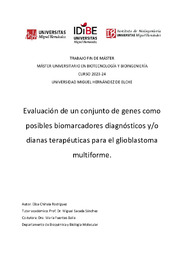Please use this identifier to cite or link to this item:
https://hdl.handle.net/11000/32448Evaluación de un conjunto de genes como posibles biomarcadores diagnósticos y/o dianas terapéuticas para el glioblastoma multiforme.
| Title: Evaluación de un conjunto de genes como posibles biomarcadores diagnósticos y/o dianas terapéuticas para el glioblastoma multiforme. |
| Authors: Chihaia Rodríguez, Elisa |
| Tutor: Saceda, Miguel Fuentes-Baile, María |
| Editor: Universidad Miguel Hérnández de Elche |
| Department: Departamentos de la UMH::Bioquímica y Biología Molecular |
| Issue Date: 2024-07 |
| URI: https://hdl.handle.net/11000/32448 |
| Abstract: El cáncer es una de las principales causas de muerte en todo el mundo. Se estimó una incidencia de alrededor de 20 millones de casos durante el año 2022 y se prevé un incremento del 76% para el año 2050. Por ello, surge la necesidad de encontrar nuevas dianas terapéuticas que permitan mejorar su diagnóstico y tratamiento, especialmente en los tumores más agresivos como el glioblastoma multiforme (GBM), que tiene una supervivencia promedio de alrededor de 15 meses después del diagnóstico. El presente trabajo se centró en la evaluación de una lista de genes relacionados con la supervivencia del paciente, obtenida en diferentes bases de datos públicas, como posibles dianas terapéuticas para el tratamiento del GBM. Para ello, se realizó un análisis transcriptómico con 142 muestras de pacientes que padecían algún tipo de tumor del sistema nervioso central. Como resultado, se identificaron 13 potenciales biomarcadores moleculares y/o dianas terapéuticas para el GBM. Posteriormente, se evaluaron tres potenciales dianas terapéuticas: PTX3, GPR126 y CDK5, en líneas celulares de GBM (HGUE-GB-16, HGUE-GB-18 y HGUE-GB-48). Para ello, se analizó el silenciamiento de estos genes, tanto de forma individual como en combinación con carmustina (BCNU), utilizando ARNs pequeños de interferencia (siRNA, del inglés “small interferening RNA”). Además, se evaluó el efecto de los inhibidores químicos CP-681301 y H89, individualmente y en combinación con BCNU, con el fin de observar si mimetizaban el efecto del silenciamiento de CDK5 y GPR126, respectivamente. Finalmente, se realizaron ensayos de RTq-PCR para determinar si existe regulación cruzada entre estos genes y otros relacionados con la respuesta a la hipoxia, angiogénesis y resistencia a la quimio y radioterapia. Los resultados obtenidos en los ensayos experimentales mostraron que PTX3, GPR126 y CDK5 están implicados en varios procesos tumorales como la proliferación celular, el desarrollo de resistencia a radioterapia, la angiogénesis y la respuesta a la hipoxia. La combinación del silenciamiento de GPR126 con BCNU ocasionó una ligera protección frente a este fármaco, mientras que el silenciamiento de CDK5 en combinación con este agente alquilante mostró una potenciación de su efecto sobre la línea HGUE-GB-16 (resistente a la BCNU). Por otro lado, el efecto observado en ambos inhibidores sobre la expresión de los genes estudiados no es comparable al del silenciamiento, demostrando efectos inespecíficos por parte de los mismos. En conclusión, PTX3, GPR126 y CDK5 pueden constituirse como potenciales biomarcadores moleculares y dianas terapéuticas para el GBM. Cancer is one of the leading causes of death worldwide. An incidence of around 20 million cases was estimated for the year 2022 and an increase of 76% is predicted for the year 2050. Therefore, the need to find new therapeutic targets arises to improve its diagnosis and treatment, especially in the most aggressive tumors such as glioblastoma multiforme (GBM), which has a median survival of about 15 months after diagnosis. This work was focused on the evaluation of a list of genes related to patient survival, obtained from different public databases, as potential therapeutic targets for the treatment of GBM. For this purpose, a transcriptomic analysis was performed with 142 samples from patients suffering from some type of central nervous system tumor. As a result, 13 potential molecular biomarkers and/or therapeutic targets for GBM were identified. Subsequently, three potential therapeutic targets, PTX3, GPR126 and CDK5, were evaluated in GBM cell lines (HGUE-GB-16, HGUE-GB-18 and HGUE-GB-48). To this end, the silencing of these genes, both individually and in combination with carmustine (BCNU), was analyzed using small interfering RNAs (siRNA). In addition, the effect of the chemical inhibitors CP-681301 and H89, individually and in combination with BCNU, was evaluated to see whether they mimicked the effect of CDK5 and GPR126 silencing, respectively. Finally, RTq-PCR assays were performed to determine whether there is crossregulation between these genes and others involved in the response to hypoxia, angiogenesis and resistance to chemo- and radiotherapy. Results obtained in experimental trials showed that PTX3, GPR126 and CDK5 are involved in several tumor processes such as cell proliferation, development of radiotherapy resistance, angiogenesis and response to hypoxia. The combination of GPR126 silencing with BCNU resulted in a slight protection of this drug, while CDK5 silencing in combination with this DNA alkylating agent revealed a potentiation of its effect on the HGUE-GB-16 cell line (resistant to BCNU). On the other hand, the effect observed for both inhibitors on the expression of the genes studied is not comparable to that of silencing, displaying nonspecific effects. In conclusion, PTX3, GPR126 and CDK5 may constitute potential molecular biomarkers and therapeutic targets for GBM. |
| Keywords/Subjects: glioblastoma biomarcadores dianas terapéuticas quimiorresistencia carmustina |
| Knowledge area: CDU: Ciencias puras y naturales: Biología |
| Type of document: info:eu-repo/semantics/masterThesis |
| Access rights: info:eu-repo/semantics/openAccess Attribution-NonCommercial-NoDerivatives 4.0 Internacional |
| Appears in Collections: TFM-M.U en Biotecnología y Bioingeniería |
.png)

